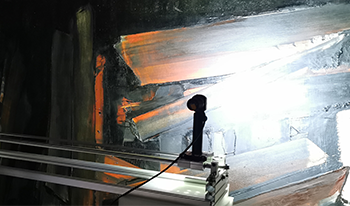
When one seeks to characterize the appearance of art paint-ings, color is the visual attribute that usually focuses most atten-tion: not only does color predominate in the reading of the pic-torial work, but it is also the attribute that we best know how to evaluate scientifically, thanks to spectrophotometers or imaging systems that have become portable and affordable, and thanks to the CIE color appearance models that allow us to convert the measured physical data into quantified visual values. However, for some modern paintings, the expression of the painter relies at least as much on gloss as on color; Pierre Soulages (1919-2022) is an exemplary case. This complicates considerably the characterization of the appearance of the paintings because the scientific definition of gloss, its link with measurable light quan-tities and the measurement of these light quantities over a whole painting are much less established than for color. This paper re-ports on the knowledge, challenges and difficulties of character-izing the gloss of painted works, by outlining the track of an im-aging system to achieve this.

Pigment classification of paintings is considered an important task in the field of cultural heritage. It helps to analyze the object and to know its historical value. This information is also essential for curators and conservators. Hyperspectral imaging technology has been used for pigment characterization for many years and has potential in its scientific analysis. Despite its advantages, there are several challenges linked with hyperspectral image acquisition. The quality of such acquired hyperspectral data can be influenced by different parameters such as focus, signal-to-noise ratio, illumination geometry, etc. Among several, we investigated the effect of four key parameters, namely focus distance, signal-to-noise ratio, integration time, and illumination geometry on pigment classification accuracy for a mockup using hyperspectral imaging in visible and near-infrared regions. The results obtained exemplify that the classification accuracy is influenced by the variation in these parameters. Focus distance and illumination angle have a significant effect on the classification accuracy compared to signal-to-noise ratio and integration time.

Application of optical metrology techniques in the collection of surface data and its 3D representation can improve the digital documentation of the conservation and restoration process of artworks. The tracking of induced change after the restoration process on cultural heritage (CH) surfaces involves a computational analysis of surface geometry. In the analysis, the conservation scientists were interested to see what impact the fillings of some holes have on its nearby surrounding during the reconstruction. In theory, the loss compensation method for stone should allow conservators to make a filling that only exists in the place of the void, but it is highly unlikely to make a filling that will only adhere to the substrate at the void site and not protrude elsewhere. According to the conservator scientists, we proposed an approach of local geometry changes to identify and visualize changes and presented the outcome through a local neighborhood distance histogram. This analysis will give us overall surface change considering each surface point and its respective neighborhood points and what impact it faced due to the reconstruction process. The work is also focused on developing the representation of each type of loss compensation method to make it more objective according to a restorer’s point of view and simplify their work visibility.

This work takes a step towards understanding fundamental aspects of appearance change in cultural heritage. Particularly, we concentrate on the case study of the Hedal Madonna – a polychrome wood sculpture dated to the mid-1200s, and an important object of ecclesiastical art and Norwegian heritage. It is covered with a layered coating that gives rise to complex reflective properties and gives the sculpture a unique appearance. We studied the goniometric, spectral, and chromatic properties of mock-ups manufactured according to medieval techniques, and also carried out accelerated aging. We compared the properties of aged and original mock-ups, and found non-trivial changes in polychrome appearance. While the color of the mock-ups did not change significantly, we observed a noticeable change in their glossiness, presumably caused by structural degradation of the surface. We also found a difference in the goniometric properties of the polychrome material’s reflectance as a function of angle. Reflectance distributions that were originally symmetric with respect to angle became asymmetric. These findings will help to understand the original appearance of the Hedal Madonna, as well as aiding the design of appropriate conservation conditions for both the original statue and its recent reconstruction.